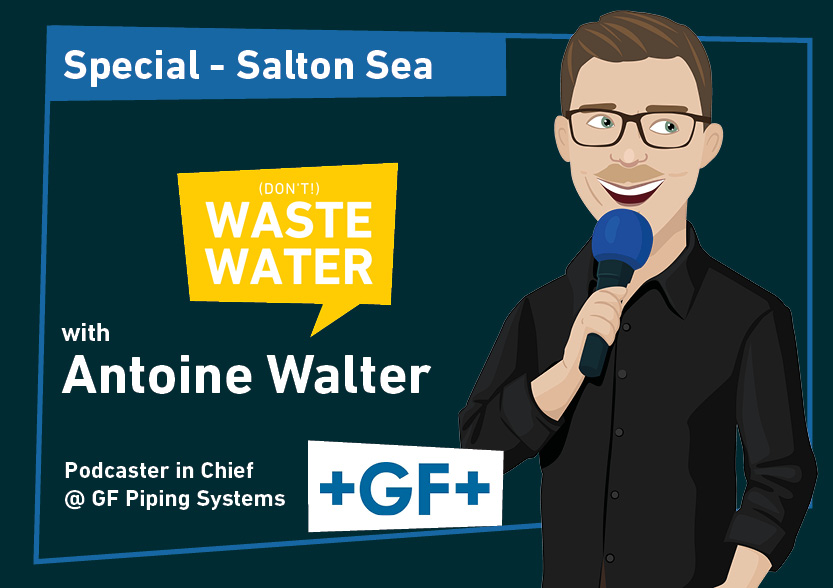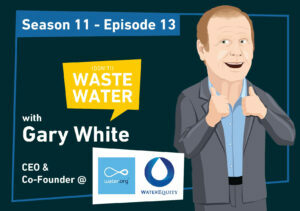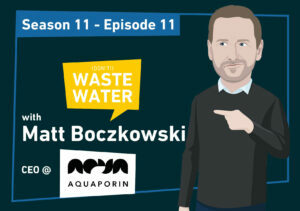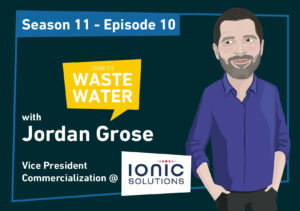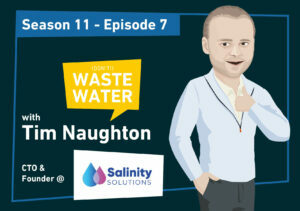Aquatech and Controlled Thermal Resources just signed a billion-dollar agreement to unlock the Salton Sea’s Lithium in California, just three months after Aquatech closed a pretty similar deal in Nevada. What does that mean for the Salton Sea and the US lithium scene?
(check out my other lithium stories!)
with 🎙️ Antoine Walter, Podcaster in Chief at GF Piping Systems
Unlocking the Salton Sea’s $26 Billion Yearly Lithium Worth
Table of contents
- Unlocking the Salton Sea’s $26 Billion Yearly Lithium Worth
- Introducing the Salton Sea
- The treasures of the Salton Sea’s geology
- 600’000 Tons a Year of Lithium Extraction Potential
- This DLE process at the Salton Sea resembles Vulcan’s one in Germany
- The water-intensive process of extracting Lithium
- Entering the “Lithium extraction graveyard” aka the Salton Sea
- Controlled Thermal Resources kept developing its Lithium project at the Salton Sea
- Scaling up the Lithium extraction at the Salton Sea
- Aquatech rapidly becomes a Lithium Refining power house
- Conclusion
- Other Episodes:
Introducing the Salton Sea
The Salton Sea is a weird animal in the south of California. Across the centuries, it sometimes existed when the Colorado River was flowing through it and sometimes fully dried out.
Yet, at the turn of the twentieth century, farmers decided to leverage Imperial County to develop irrigated agriculture. They diverted some water from the river, and then some more, and then too much, and it broke one of the canal’s head gates, letting Colorado water flow into the Salton Basin for two years before it got repaired.
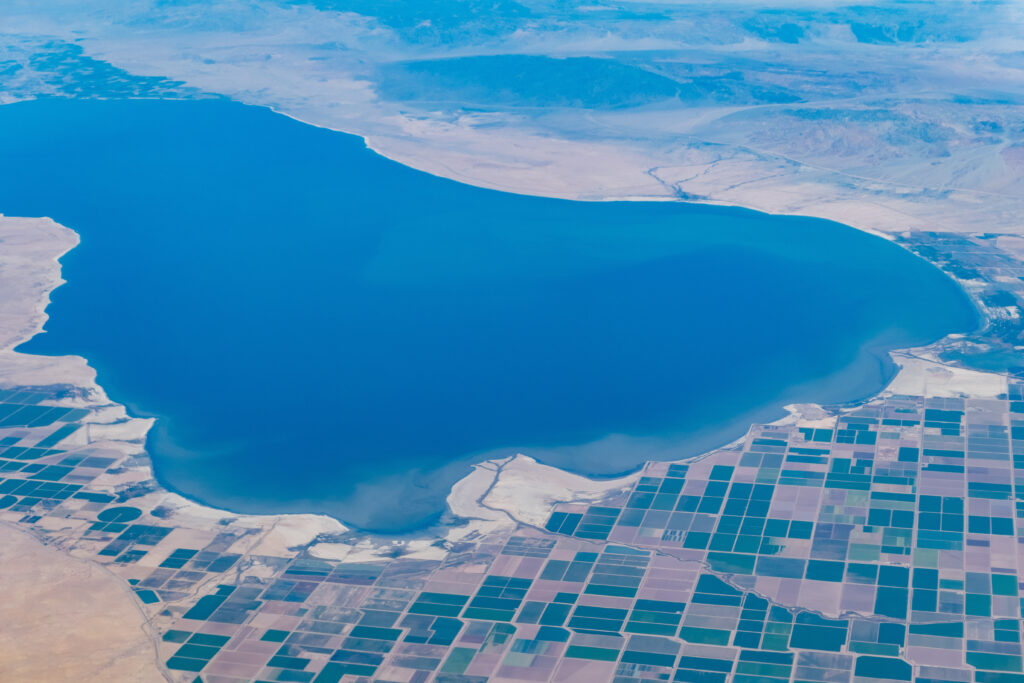
That’s how the Salton Sea got reborn and kept existing, as it collected irrigation run-offs.
Once a popular touristic spot
Over the next decades, it became a place where Frank Sinatra took holidays, it experienced a tourism boom in the 1950s to early 70s, but irrigation got more efficient, water run-offs kind of stopped, and the Sea started to dry up again.
This unveiled some of the troublesome substances that accumulated in the water body, which started concentrating as more and more water evaporated, ultimately turning the place overall into an environmental hazard, whose odors and dust could be felt as far as Los Angeles.

The treasures of the Salton Sea’s geology
What’s that backstory to do with our billion-dollar story? Quite a lot.
Actually, the geology of the Salton Sea is somewhat unique, as the islands you can see in the Lake are indeed volcanoes. And geothermal sources exist pretty close to the Sea’s surface, making it a perfect place to produce geothermal energy.
Since the 80s, eleven geothermal power plants got built, ten operated by a Berkshire Hattaway subsidiary and one by EnergySource. And there’s one more that’s currently being developed by a company called Controlled Thermal Resources, actually the one company that just signed a big contract with Aquatech.



Geothermal energy is pretty cool in itself, but it wouldn’t be so exciting if it wasn’t for one more specificity of the Salton brines, mixed in that hot soup, there’s Lithium and quite a lot of it.
600’000 Tons a Year of Lithium Extraction Potential
According to the US government’s estimates, the Salton Sea may be able to provide around 600’000 tons of Lithium per year. At today’s lithium spot price of 43’000 dollars per ton, that’s a potential 26 billion dollars.
But there’s a problem, as Tony Strobbe explains.
Simbol Materials disappeared in 2015 despite successful piloting in direct Lithium extraction at the Salton Sea
Companies have been trying to unlock the Salton Sea’s Lithium for a decade now. In 2013, Simbol Materials built a demonstration plant for direct lithium extraction at the EnergySource power plant. It worked, but it was far from being economical. To be fair, at the time, the lithium spot price was 7 times lower than it is today.

Elon Musk attempted to acquire the company for 325 million dollars, but the deal didn’t close, and in 2015, Simbol Materials ran out of cash and disappeared.
Simbol Materials had a promising process to directly extract the Salton Sea’s lithium
But let’s take a note here; trust me, it will matter later: from a technical standpoint, the company was leveraging improved aluminum-based sorbents.
This absorbent is pretty much the same family of absorbants that has been around since the sixties when Dow actually developed this. And in the nineties was actually commercially made available by a company called FMC, now Livent.
Generation 1 DLE is around commercially since the 1990s
This is what Ben Sparrow, the CEO of Saltworks described to me as Generation 1 Direct Lithium Extraction.
This way to directly extract Lithium is working at scale and being used by Livent in Argentina for 25 years and by SunResin in China for at least 10 years. With one caveat, though, these plants don’t fully directly extract Lithium. They still use evaporation ponds as a sequel step in the process.
This DLE process at the Salton Sea resembles Vulcan’s one in Germany
Now the reason why Cris Moreno, the Deputy CEO of Vulcan Energy Resources you just heard, knows alumina-based sorbent so well, is because that’s also the process Vulcan plans to implement in its German Lithium and geothermal power project.
But can you visually spot the difference between Vulcan’s project site and the Salton Sea?

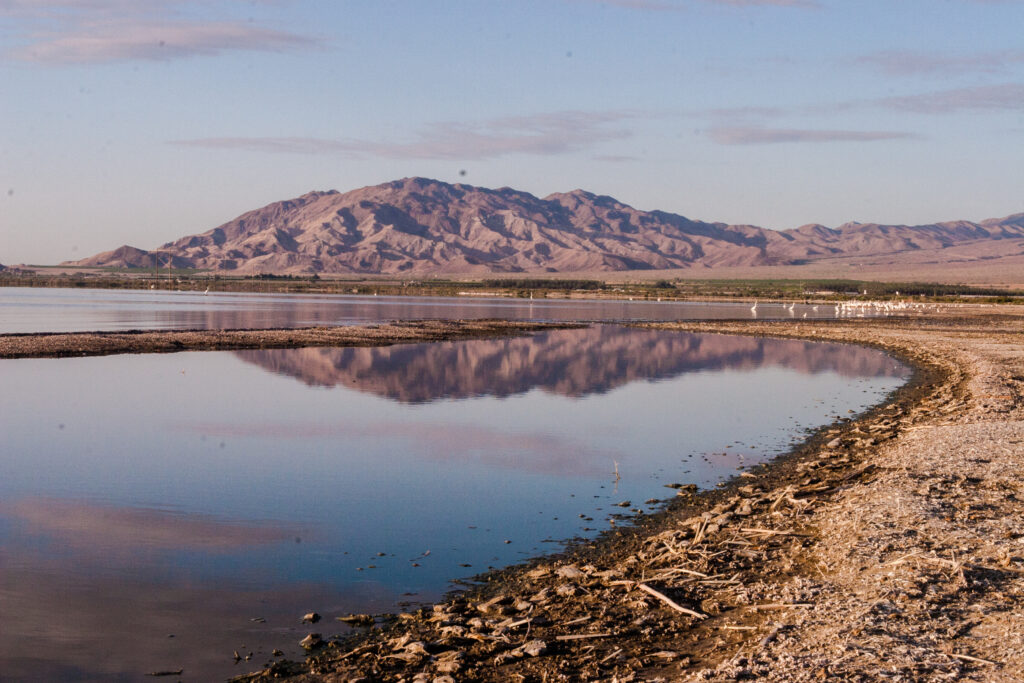
Look at the color: green versus yellow-ish. Oh, and maybe the presence of the Rhine River just next to the german project.
Indeed, as Ben explained, Alumina-based adsorbents are a water elution: so they need water to run. How much?
The water-intensive process of extracting Lithium
According to Livent’s sustainability report, about 72 liters of water per kilogram of Lithium.
Another note here: I’m comparing apples with potatoes, each brine is specific, for sure, and Livent’s numbers are for their Hombre Muerto operation in Argentina, which leverages lithium concentrations about 4 times higher than the Salton Sea. So take it with a pinch of lithium-rich salt: the same process in California would probably use even more water.
The Salton Sea is already shrinking and in Water stress. Can it sustain more abstractions?
Anyways, as water is not plentiful around a sea that’s evaporating and shrinking and where the State even evaluates the option to refill it with desalinated ocean water, it made sense to look for alternative technologies.
That’s why, when Controlled Thermal Resources entered the Salton Sea geothermal and Lithium game, it brought in a new type of Direct Lithium Extraction: Ion Exchange.
The company it teamed up with to do so is arguably one of the coolest kids in the DLE scene: Lilac Solutions. Oakland-based, backed by Breakthrough Energy Ventures, pretty successful in its Argentinan endeavors, and claiming needing only 10 to 20 liters of water per kilogram of lithium.

Entering the “Lithium extraction graveyard” aka the Salton Sea
Yet, CEO David Snydacker was fully in the know that the Salton Sea was a difficult place to roll out: it’s a “graveyard for lithium extraction technologies” as he told the Los Angeles Times.
At the same time, Lilac also worked with Berkshire Hattaway – the company running 10 of the 11 geothermal power plants around the Sea – to there as well pilot the extraction of lithium, while the third player, EnergySource, developed its own technology suite: iLiad.
Technically, it kinda worked for all of them, but with many drawbacks. As David Snydacker told Forbes: “There are challenges related to the very high temperatures and the materials, including toxic materials, that are dissolved into it.”
It’s a challenging environment for DLE to strive
As a result, Berkshire Hattaway has sometimes been rumored to fully pull the plug on lithium – even if I suspect they’re testing something new.
EnergySource has been successful in licensing its technology to another project around the Great Salt Lake in Utah, but didn’t reach as impressive results in its own Salton Sea facilities.
And Lilac decided in August 2022 to give up on the Salton Sea and refocus on all the other projects where they’re much more successful.
Controlled Thermal Resources kept developing its Lithium project at the Salton Sea
But Controlled Thermal Resources didn’t give up, and in their Q3 2022 update, they revealed that they not only kept on track with their Stage 1 development but that they had appointed Hargrove as an EPC contractor and picked an unnamed technology for their DLE process.
Wanna Play a Game? Let’s try to find out who that may be!
Controlled Thermal Resources has evaluated ion exchange, adsorption, and solvent extraction. They only consider technologies with a long track record of achievement for application.
So that eliminates ion exchange and solvent extraction, it’s gonna be adsorption, right? Bingo, adsorption technology.
But that adsorbent could still be what Ben Sparrow defined as Generation 2:
This is, for instance, what Standard Lithium is using in their El Dorado project in Arkansas.
Controlled Thermal Resources improved Generation 1 Direct Lithium Extraction
But when reading the perks Controlled Thermal Resources sees in its process: an elution with water instead of hydrochloric acid, which substantially reduces reagent consumption, it’s all clear.
It’s not Gen2, it’s Gen1, and it’s a kind of full circle back to what Simbol Materials tested back in 2013 – but with higher recovery rates.
Rumors say the process could be delivered by SunResin – I couldn’t verify it, so this is me, arms waving; the description is accurate, but it could come from anyone that got inspired at some point by 1960 Dow Chemicals.
Scaling up the Lithium extraction at the Salton Sea
Now you’re probably wondering. Why did I tell you all of that? What does that have to do with this mysterious water technology company signing a billion-dollar agreement with Controlled Thermal Resources?
Well, I wanted to share you a bit of context. What’s really special about the Salton Sea is the full road from the hot soup to a produced lithium chloride.
If Controlled Thermal Resources is confident now, it can take its 3’000 hours of demo plant experience that achieved a 95 to 97% lithium recovery rate, and upscale it tenfold, then I would also trust their chosen partner to be able to take it from a technical grade lithium chloride eluate to a battery-grade lithium hydroxide. Indeed:
Devesh Sharma is the CEO of Aquatech International, and yes, Aquatech is the company I’m teasing you since my introduction.
Aquatech helps with the scale up by leveraging reverse-ZLD
But you might wonder: how’s lithium refining a Water treatment process? And how would a water tech company have 40 years of experience in it?
Actually, there’s a wastewater treatment application called Zero Liquid Discharge that’s been around for decades, and that helps industrial players to prevent discharging polluted effluents to the environment.
Aquatech rapidly becomes a Lithium Refining power house
Aquatech is actively in the process of winning a solid market share in this lithium refining market: They got chosen by Lithium Americas to build the Lithium Refinery at Thacker Pass, Nevada, and now CTR appoints them for this Salton Sea endeavor:
But wait, we need to talk about that one billion dollars
Why does that matter? Well, according to my research, Aquatech has an about 150 million dollars yearly turnover. So how would Aquatech digest an order that’s over 6 times its yearly turnover?
Well, that’s where I think the Press Release is misleading.
Still not to the “billion” extent, the press release teases
I’m not a native English speaker; you hear it every week, so don’t roll your eyes while I try to dissect the semantics.
If it was a $1 billion contract, the headline should rather be CTR AWARDS Aquatech ITS Facility in California, right?
Beyond the semantics, the way I understand it is that the entire Lithium Hydroxide Facility, from drilling to battery-grade product through DLE and utilities, is a 1 billion dollar project, and Aquatech got awarded the sub-contract for the Lithium Refinery work package.
And that sounds about logical, if I compare it to Standard Lithium’s green field Smackover project: for a pretty similar Lithium Hydroxide output, they anticipate an 870 million dollars CAPEX, of which 130 million dollars shall be spent on the Lithium Hydroxide conversion plant.
Once again, I’m comparing bananas with coly-flowers, as the source brine, processes and eluates widely differ between the Salton Sea and the Smackover formation, but still, I can’t be too wrong with my order of magnitude.
Conclusion
So, I’d say minus points for the PR team that wrote this press release, at least for a non-native English-speaking audience, that title is misleading.
What’s our conclusion for today.
First, despite all I ranted about, this is exciting news, at least to me. I’m not Joe “Mr Lithium” Lowry – you shall definitely listen to his podcast, it’s another level than stupid me – I’m a lithium muggle. But to me, the Salton Sea was at that stage an unsolved riddle, with great potential but so many issues to solve, that it would probably own the judgment of
“Sounds good, doesn’t work”
And now, it seems like CTR progresses on one end with its 1.4 billion dollars geothermal power project, and on the other one with its 1 billion dollars lithium production one.
The questions I’d like to ask to Controlled Thermal Resources
I still have many questions open though:
- I could not find a definitive feasibility study. Did I miss it, or is it still to come?
- What are the improvements to Gen1 DLE that Controlled Thermal Resources developed to reach up to 98% lithium extraction yield? How much water do they need to achieve that? Where does the water come from? How do they prevent all the other compounds in the hot soup from precipitating out the lithium when they remove them? And a zillion more process questions; I’m a water geek, sorry.
- How do they finance their project? They have offtake agreements with Stellantis and General Motors, which is also an investor. But does that cover 100% of the costs?
- What are the next steps in the vertical they intend to build? Will they move on with the project to colocate a Gigafactory at the Salton Sea in its aggressive atmosphere?
And many more, so, CTR, when you watch this, I’d be so happy to have you on my podcast microphone to explore all of this!
The perspectives it opens at the Salton Sea and beyond
And zooming out, if this project moves on, is that a positive sign for Berkshire Hattaway and EnergySource?
Finally, even if Aquatech doesn’t multiply its revenue by 6 just on this project, it would still double it, and somehow – me waving arms again – triple it with the Thacker Pass contract. What does that mean for all industrial water technology companies? A great opportunity? A great challenge? All of the above?
Well, as you see, I have many questions left, so if answering them is of interest to you, come tell me in the comments and make sure to subscribe.

